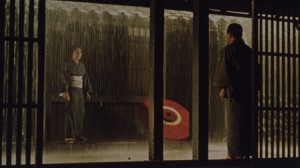So, we’re going to get a little arty now. Floating Weeds is one of the few color films by Japanese master filmmaker Yasujiro Ozu. Ozu is known for his intimate family dramas that were set in his contemporary Japan. His style is instantly recognizable, he often centers actors in the frame, the camera almost never moves, and the cuts are long.
Ozu is probably best known for Tokyo Story, a movie that shows up on a lot of those “Greatest Movies of All-time” lists. That is a great movie, but I like Floating Weeds a little better.
Recurring themes of family duty, sacrifice, growing old, and the generation gap show up over and over again in Ozu’s movies. Because of his themes and his particular style he’s an easy director to either love or hate.
The Set-Up
 A traveling acting troupe comes into a small town to do a string of performances. Komajuro (Ganjirô Nakamura), the troupe’s leading man and director, has an old flame in town, Oyoshi (Haruko Sugimura). Years ago, Oyoshi had Komajuro’s son Kiyoshi (Hiroshi Kawaguchi). Kiyoshi is now grown up, and grew up believing Komajuro was his uncle, who would only visit occasionally. Komajuro’s current mistress is the leading lady Sumiko (Machiko Kyô). Sumiko suspects there are ulterior motives for bringing their act to such a small town. Her curiosity threatens to upset Komajuro’s constructed life with Oyoshi and Kiyoshi. Because she is jealous of Oyoshi she bribes a young ingénue, Kayo (Ayako Wakao) to seduce Kiyoshi.
A traveling acting troupe comes into a small town to do a string of performances. Komajuro (Ganjirô Nakamura), the troupe’s leading man and director, has an old flame in town, Oyoshi (Haruko Sugimura). Years ago, Oyoshi had Komajuro’s son Kiyoshi (Hiroshi Kawaguchi). Kiyoshi is now grown up, and grew up believing Komajuro was his uncle, who would only visit occasionally. Komajuro’s current mistress is the leading lady Sumiko (Machiko Kyô). Sumiko suspects there are ulterior motives for bringing their act to such a small town. Her curiosity threatens to upset Komajuro’s constructed life with Oyoshi and Kiyoshi. Because she is jealous of Oyoshi she bribes a young ingénue, Kayo (Ayako Wakao) to seduce Kiyoshi.
The play is unsuccessful and closes shortly. Kiyoshi attributes this to being a samurai play and not one that a modern audience can relate to. After the play’s closure the troupe is stranded. They are unable to book showings anywhere else and didn’t make enough money for passage out. After the play’s close, a number of revelations come out about all the main characters’ pasts and their motives.
Why It’s Great
My summary makes the movie sound complicated, but the slow pace of the movie makes the plot complications easy to follow. The typical Ozu themes are apparent here and delivered as well as usual. What sets it apart if apart from other Ozu works are two things – the complexity of the characters and the film’s color.
Despite being his first film in color, Ozu is a master of it. The color palette really gives the audience the feel of the town and the characters. The heat of the summer is mentioned a few times in the movie, and the colors of the film bolster the impression of heat.
In most Ozu movies I have seen the characters are believable but one-dimensional. Someone is often sacrificing their happiness for their family members. Sometimes their family members are as well; sometimes their family members are selfish and concerned with only their own happiness. But there are usually clear “saints” and clear “selfish” people. In this movie, the main cast feel like real people. They each have their moments of selfishness and their moments of sacrifice. The audience’s view of each character will likely change throughout the movie as different aspects of each one are revealed.
This is my favorite Ozu movie and in my opinion his best. The characters are more realistic than in other Ozu movies and the story is one of his more engrossing ones. If you are a fan of Ozu, you should definitely check this out. If you haven’t seen any of his work, I believe that this is the best place to start.